The content of the article
A tick is a spider-like parasite that poses a danger to both humans and pets. Once in the body, it not only feeds on the host’s blood, but also infects it with dangerous diseases. The dog is in second place with a tick attack, as during walks there is regular contact with tall grass, where parasites hide. The process of biting a dog may not provide any pain - the pet becomes restless only after a few hours after the attack. If you notice a blood-sucking tick from your four-legged friend, the best option would be to contact an experienced veterinarian immediately. But if you do not want to waste time, you can use several useful tips that you will find in the article.
Spring is the peak of tick activity
After winter frosts, mites that are in hibernation begin to actively seek food, since in spring parasites lay larvae and multiply intensively. The most dangerous time when you should be afraid of tick attacks is a gradual warming after freezing temperatures. The common belief that ticks attack from a few meters on an alleged victim is false. In fact, with the help of radar, parasites determine a warm-blooded creature and cling to clothing, hair or wool. The tick can crawl over the dog for 2-3 hours, in search of the most suitable place for a bite - thin skin in the abdomen, thigh, ears. Only after the ideal site is found, the parasite begins to suck blood from its owner.
The blood-sucking spider not only provides discomfort to the dog. In the process of feeding, the tick emits special hazardous substances. He is a potential distributor of diseases such as babesiosis and borreliosis, which can lead the dog to death. In order to protect your pet from such a danger, it is necessary to identify and eliminate the tick as soon as possible.
How to recognize a tick on a dog
If you notice a tick on the human body is quite simple, then it is difficult to discern a parasite on a dog. This is especially true for long-haired dogs - the pet does not find a place for pain, and the owner can not understand what is the matter. Experienced veterinarians advise you not to forget to comb the dog after each walk, most often in the spring. Using a comb with rare teeth, comb the dog’s hair against growth, paying particular attention to the area of the skull, abdomen and ears. It will also be useful to stroke the dog with sliding movements over the coat - you yourself can feel any irregularities on the skin.
It is very difficult to confuse a tick with another arachnid insect - it looks brown or black in color, no more than 5 mm in length, has 8 legs and a small head. The body of the parasite resembles a shield - it is equally durable and repeats the shape of this object.
After the tick has stuck into the skin with its head, outside the body remains, which is very similar to a convex mole or bloated pea of a gray, dirty yellow or pink hue. It is necessary to remove the parasite as soon as possible, since the more the tick drinks blood, the higher the risk of infection with serious diseases.
How to get a tick out of a dog
If you still notice a tick in the dog, the first condition is not to panic. Try to calm the dog. To do this, you can sprinkle the area with the parasite anesthetic spray, for example, novocaine. Next, follow the following plan:
- Cut the hair in the area where the tick is located.Smooth the nearest vegetation with oil, so that the hairs do not interfere.
- Make some ring. The higher its height, the better. Install the ring so that the tick is in the middle there. Press the ring firmly against the dog’s body and pour oil into it. The head of the tick is immersed in the skin, so the whole body that is left outside breathes. With the help of oil, which eliminates the ingress of air, you will leave the parasite without oxygen, so after a few minutes it will be forced to pull out its head and stop draining blood. You can also create an airtight film with a greasy cream, multi-layer nail polish, paraffin, gasoline and petroleum jelly.
- If the oil does not help you and the tick continues to feed on your dog’s blood, you need to prepare tweezers or special veterinary devices to remove the parasite. A magnifying glass is also required. Carefully examine the tick before proceeding to stretch it. The head and paws come off easily, so you should be as careful as possible. With tweezers, grab the tick as close to the skin as possible - twist the spider with gentle, gentle movements, as if you were loosening a baby’s milk tooth. Do not pull on yourself with all the force! So you leave the head of the tick in the dog’s skin and removing it separately is much more difficult than with the insect.
- After you finally pulled out the tick, it is urgently necessary to disinfect the site of the bite. Zelenka or iodine will not work in such cases. Use alcohol or a special disinfectant solution.
- Do not throw away the tick; rather, put it in a matchbox and take it to the laboratory. So you will sooner find out if the parasite that attacked your dog was infected and soon start treatment.
Prevention against tick attack
If you want to protect your dog from unpleasant procedures for removing the tick, before each walk, especially in the spring and in the first month of summer, spray the pet with special means that repel ticks. In stores you can also find special collars that prevent ticks from penetrating the surface of the dogs skin. Do not forget to comb the four-legged friend after each walk and examine him in case of a tick bite.
If your dog was accidentally bitten by a tick, this is not a reason for panic. It is enough to carefully remove the parasite and send it to the laboratory to determine the infection with diseases.
Video: how to pull a tick with a rope











Submit
Buy a special Nippes tweezers for twisting ticks from a dog pharmacy. After all, animals spin, twist, and it is not so easy for them to take out a tick with a thread or tweezers. And the twistler brought the connector under the neck of the tick, turned it once or twice and the tick easily twisted out of the animal’s skin. The procedure takes less than a minute.
We are rare in nature, but we caught nonetheless. I bought special tweezers and drops from parasites at the pet store, before that I had never dripped. We were given a spot-on, since then we have been using them for the second year. I dripped from the pipette onto the tick, after 20 minutes it fell out, these special ticks were never needed. Although the store said that it might not fall off, then it was necessary to unscrew the tick with their help. They used to wear a collar from fleas, now we can do without it, drops from fleas, water-eaters, lice also help.